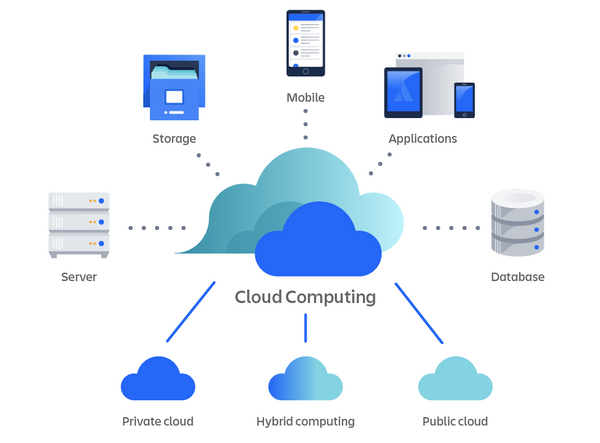Everything You Need to Know About the Cloud: A Complete Guide to Understanding and Making the Most of Cloud Computing
Cloud computing has become one of the hottest concepts in the world of technology , allowing you to store, manage, and access your data and applications from any device connected to the Internet. With the cloud, you don't need physical storage space or hardware resources to manage. It's like having a large digital box at your disposal, always accessible and ready to host your files and applications.
You will learn how to choose the cloud service that best suits your needs, how to ensure the security of your data and how to exploit all the potential that the cloud offers, both for personal use and for business needs. So, get ready to discover everything about cloud computing and open up a world of digital possibilities!

Introduction to Cloud Computing
Cloud computing has become one of the hottest concepts in the world of technology, allowing you to store , manage, and access your data and applications from any device connected to the Internet. With the cloud, you don’t need physical storage space or hardware resources to manage. It’s like having a big digital box, always accessible and ready to host your files and applications.
Cloud computing works through a network of remote servers that host and manage users' data and applications. These servers are accessible over the Internet and allow users to store their data securely and use applications without having to install them locally on their devices.
Cloud computing is based on three main types of services: Infrastructure as a Service ( IaaS ), Platform as a Service ( PaaS ), and Software as a Service ( SaaS ). Each of these offers different levels of control and customization, allowing users to adapt the service to their specific needs.
The Benefits of Cloud Computing
Cloud computing offers many benefits that can improve your digital life. One of the main benefits is flexibility . With the cloud, you can access your data and applications from any location and device connected to the Internet. You are no longer limited to a single device or physical location to access your files.
In addition, cloud computing also offers greater scalability . You can easily increase or decrease storage and computing resources based on your needs, without having to purchase or manage additional hardware. This allows you to adapt resources to your needs easily and efficiently.
Another advantage of cloud computing is cost reduction . With the cloud, you do not need to invest in expensive servers and infrastructure. Costs are based on the actual consumption of resources, allowing you to pay only for what you actually use. This can be especially advantageous for small businesses or those with limited budgets.
Finally, cloud computing also offers greater data security . Cloud service providers implement advanced security measures to protect your data from unauthorized access or loss. Additionally, your data is replicated across multiple servers, ensuring greater reliability and protection in the event of hardware failures.

Types of Cloud Computing Services
As mentioned above, cloud computing is based on three main types of services: Infrastructure as a Service ( IaaS ), Platform as a Service ( PaaS ), and Software as a Service ( SaaS ). Each of these offers different levels of control and customization, allowing users to adapt the service to their specific needs.
Infrastructure as a Service (IaaS): This type of service offers virtual infrastructure such as servers , storage , and networking . Users can use these resources to build and manage their own applications and development environments. IaaS offers a high degree of control and flexibility, allowing users to customize the infrastructure to their needs.
Platform as a Service (PaaS): PaaS provides a complete development environment , including infrastructure, operating system, and development tools. Developers can use PaaS to build, test, and deploy their applications without having to worry about managing the underlying infrastructure. PaaS offers a high degree of productivity and speed in application development.
Software as a Service (SaaS): SaaS offers ready-to-use applications that can be used directly by end users. This type of service is very common for applications such as document management, CRM , and email . Users can access the application through a web browser or a dedicated application without having to install or manage the application locally.
Common Cloud Misconceptions
Despite the many benefits that cloud computing offers, there are still some common misconceptions that can create doubts or concerns . One of the main misconceptions is data security . Some people worry that their data is not safe in the cloud, but in reality, cloud service providers implement advanced security measures to protect user data.
Another misconception is the loss of control over your data. Some users fear that they will not have complete control over their data when it is stored in the cloud. However, cloud service providers offer options for data backup and recovery, allowing users to have some level of control over their data.
Another common misconception is about costs . Some users worry that moving to the cloud will be expensive or inconvenient. However, cloud costs are based on the actual consumption of resources, allowing you to pay only for what you actually use. In many cases, cloud can be a more cost-effective solution than purchasing and managing hardware infrastructure.
It is important to understand and dispel these misconceptions in order to fully exploit the potential of cloud computing.

How to choose the right cloud provider
Choosing the right cloud provider is a crucial step in reaping the benefits of cloud computing. There are several factors to consider when choosing a provider. One of the main factors is the reputation and reliability of the provider. It is important to choose a reliable provider that offers good technical support and has a good reputation in the industry.
Another factor to consider is data security . It is important to choose a provider that implements advanced security measures to protect user data. It is advisable to check the provider's security certifications and read user reviews to get an idea of the quality of the service offered.
Other factors to consider include the flexibility and scalability of the service offered by the provider. It is important to choose a provider that offers customization options and allows you to scale resources up or down as needed.
Finally, it is also important to consider the costs of the service offered by the provider. It is advisable to evaluate the prices and compare them with the quality of the service offered to make the best choice based on your needs and budget.
Cloud Security and Data Privacy
Cloud security and data privacy are of paramount importance in the world of cloud computing. It is important to choose a provider that implements advanced security measures to protect user data. Some of the common security measures include multi-factor authentication , data encryption , access management, and protection from external threats.
Additionally, it is advisable to carefully read the provider’s terms of service to understand how they handle user data and what their privacy policies are. It is important to ensure that the provider complies with privacy laws and has a strict data protection policy.
Some tips for ensuring the security of your data in the cloud include choosing strong and unique passwords , regularly monitoring your account activity, and regularly backing up your data.
Migrating to the Cloud: Best Practices and Considerations
Migrating to the cloud can be a complex process and requires proper planning . It is important to consider several aspects during the migration.
One of the first steps to take is to evaluate the applications and data to be migrated . It is important to identify which applications and data are suitable for the cloud and which may require modification or adaptation. It is advisable to start with less critical or less complex applications to become familiar with the migration process.
During migration, it is important to keep track of resources used to avoid waste or unnecessary costs. It is recommended to use resource monitoring and management tools to control and optimize resource usage in the cloud.
Additionally, it is important to have a data backup and recovery plan during migration. It is advisable to make regular data backups and verify the correctness of the migrated data to avoid any information loss.
Finally, it is important to involve your staff and provide adequate cloud training. It is advisable to involve key people in the migration process and provide them with the necessary training to use the cloud properly.

Cost Optimization and Resource Management in the Cloud
Cost optimization and resource management in the cloud are important issues to ensure the efficiency and cost-effectiveness of cloud computing usage.
One of the strategies to optimize costs is to adopt a pay-as-you-go approach, where you only pay for the resources you actually use. It is advisable to monitor and control the resource usage regularly to identify any waste or underutilized resources. You can use monitoring and resource management tools to control the usage and optimize the resources in the cloud.
Additionally, you can use cost-saving strategies such as resource reuse, purchasing reserved resources, or using reservation rates to obtain discounts on resource costs.
Cloud resource management also includes planning and allocating resources as needed. It is important to plan the required resources in advance to avoid wastage or insufficient resources. You can use resource monitoring tools to plan resource allocation efficiently.
Finally, it is important to regularly evaluate the performance and efficiency of resources in the cloud to identify potential improvements and optimizations.
Trends and Future Developments in Cloud Computing
Cloud computing is an ever-evolving industry, and there are many future trends and developments to keep an eye on.
One of the major trends is multi-cloud adoption , where companies use multiple cloud providers to diversify risks and leverage different vendor offerings. This trend provides more flexibility and choice for companies.
Another trend is the adoption of serverless computing , where applications run without the need to manage the underlying infrastructure. This trend offers greater productivity and speed in application development , eliminating the need to manage and scale infrastructure.
Additionally, machine learning and artificial intelligence are playing an increasingly important role in cloud computing. Cloud service providers are offering machine learning and artificial intelligence services that allow businesses to better leverage data and gain actionable insights to make better decisions.
Finally, cloud computing is becoming more accessible and affordable with the adoption of technologies such as edge computing and 5G . These technologies allow computing resources to be moved closer to users and reduce latency, ensuring a better user experience and faster access to cloud services.

Harnessing the potential of the cloud for your business
Cloud computing offers numerous opportunities to improve your digital life, both personally and in business . With the cloud, you can access your data and applications from any device connected to the Internet, benefit from greater flexibility and scalability, reduce costs and improve data security.
To maximize the potential of the cloud for your business, it is important to choose the right cloud provider, ensure data security, and adopt best practices for migration and resource management. It is also important to keep an eye on future trends and developments in cloud computing to stay up to date with new opportunities and technologies.
Cloud computing is a powerful resource that can transform your digital life and improve the efficiency and convenience of your business processes. Don't miss the opportunity to harness the full potential of the cloud!







